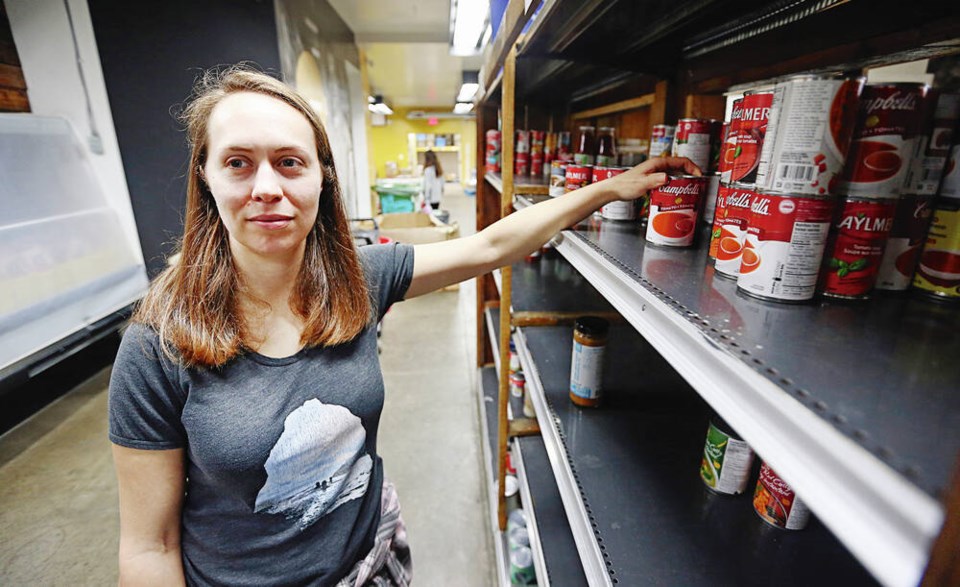Greater Victoria’s relatively low 3.8 per cent unemployment rate is disguising the many households that are dealing with financial difficulties due to rising expenses and higher interest rates.
The Mustard Seed’s food-security distribution centre handed out 27 per cent more supplies in the first 10 months of this year compared with the same months last year, says Colleen Sparks, director of development. The centre works with about 75 social agencies.
Demand is predicted to continue rising because November, December and January are always extra-busy months.
Families, newcomers to Canada and international students are among those showing up in increasing numbers, Sparks said Friday. She encourages students to seek out organizations providing food in their community.
“We have families that are coming in that probably would never have used the food bank before.”
Interest is especially strong for holiday hampers this year, she said.
At the same time, the agency’s recent food drive brought in fewer donations than in the past, Sparks said Friday.
“Definitely our pantries are lower at this point and we know that the demand is just that much higher.”
Statistics Canada said in its monthly labour-force survey report that one in three Canadians reported living in a household that found it difficult or very difficult to meet its financial needs when it comes to transportation, housing, food, clothing and other necessary expenses over the previous four weeks.
While that figure is down slightly from a year ago, it’s still up considerably from October 2020, when 20.4 per cent of Canadians reported the same thing.
Greater Victoria’s unemployment rate of 3.8 per cent in October was the same as in September. B.C. also held steady month over month with an overall rate of 5.4 per cent. Nationally, the unemployment rate rose to 5.7 per cent last month as job opportunities became less plentiful in an economy weighed down by high interest rates.
High rent costs in the capital region and larger mortgage payments are factors in a household’s bottom line, Sparks said.
Anyone wanting to donate money can go to mustardseed.ca. Financial donations allow the non-profit organization to buy about three times as much food because of the large quantities it purchases.
Within the capital region, health care and social assistance jobs rose to 38,700 last month from 31,600 in October of last year. Business, building and other support services climbed to 8,700 from 4,700 a year earlier.
Wholesale and retail trade rose to 32,400 jobs in October from 31,000 the same month in 2022. Accommodation and food services moved up to 18,300 last month from 15,400 the previous year.
Construction jobs declined to 17,300 in October from 20,200 a year earlier. Transportation and warehousing saw a slight drop to 8,200 last month from 8,500 in October 2022.
Educational services slid to 18,000 jobs last month from 19,100 a year ago. Professional, scientific and technical services declined to 21,400 in October from 22,800 a year ago.
Canada’s economy added a modest 18,000 jobs last month. That gain was not enough to keep the unemployment rate from rising as the pace of job creation trails population growth.
Canada’s unemployment rate was 5.5 per cent in September.
October marks the fourth increase in the jobless rate over the past six months and adds another data point in favour of the Bank of Canada’s rate pause, according to economists.
“While the headline job gain was uneventful, make no mistake that the underlying picture for Canada’s labour market is softening,” wrote Bank of Montreal chief economist Douglas Porter in a note to clients.
Employment rose last month in construction and information and culture and recreation, but the increase was offset by declines in wholesale and retail trade, as well as manufacturing.
Wages continued to grow quickly, but the pace slowed last month compared to September, with average hourly wages up 4.8 per cent to $34.08 from a year ago.
The Bank of Canada opted to hold its key interest rate steady at five per cent during its last two decision meetings, largely due to growing evidence that the economy is feeling the impact of higher rates.
Gross domestic product data showed the economy shrank in the second quarter and a preliminary estimate from Statistics Canada suggests another contraction in the third quarter.
The labour market has remained relatively resilient since interest rates started to rise in March 2022 as employers maintained their appetite for hiring post-pandemic. But job vacancies have been on the decline this year and Friday’s report suggests job prospects are continuing to dwindle.
Among those who were unemployed in September, a larger proportion stayed unemployed in October than 12 months prior, suggesting “job seekers are facing more difficulties finding employment than a year ago.”
Employment opportunities are expected to become even more sparse as the effects of previous rate hikes increasingly filter through the economy.
“In no way should the Bank of Canada hike again, given everything we know right now,” said James Orlando, TD’s director of economics. “We think they’ve done enough. And they should just … hold steady right now and [let] the economy continue to slow.”
— With Nojoud Al Mallees, The Canadian Press



